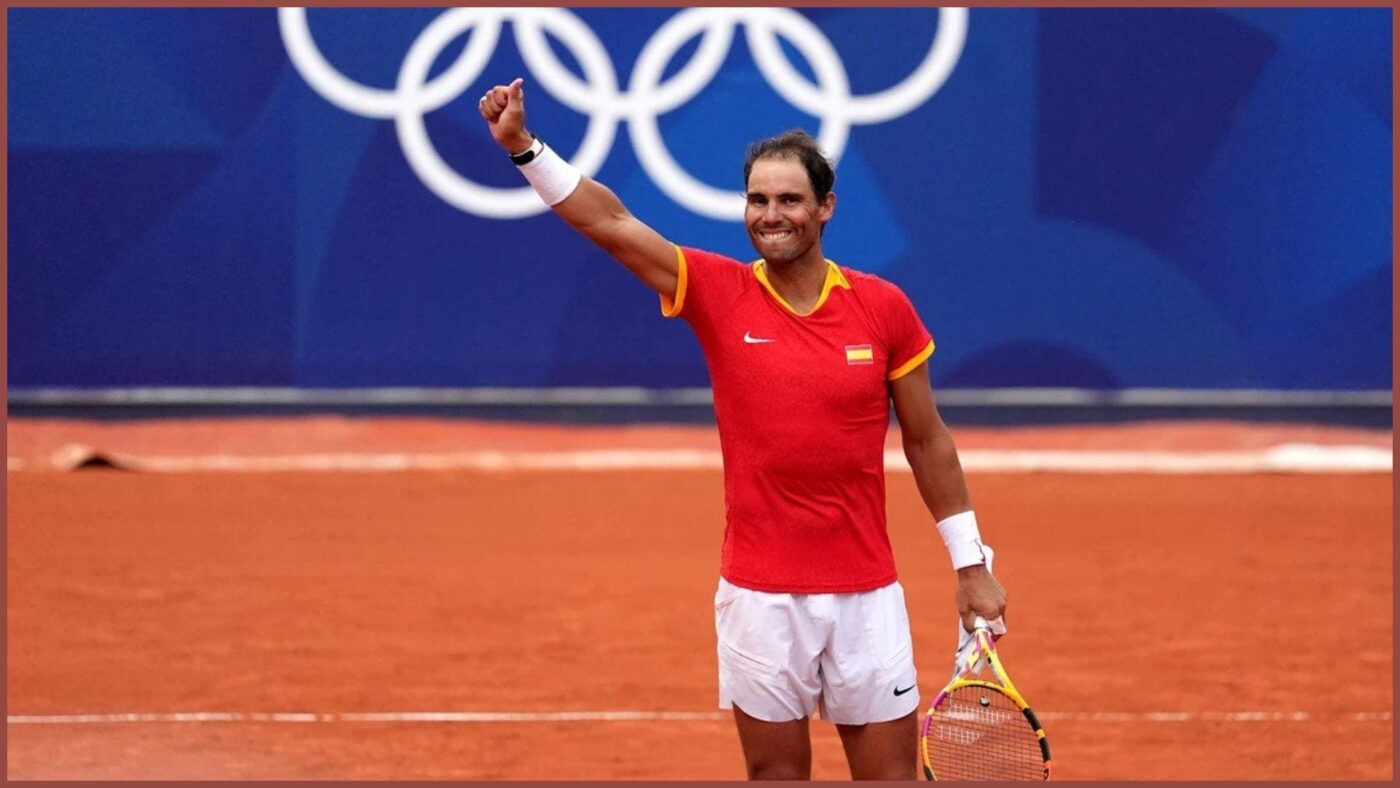News
A Comprehensive Review of Rafael Nadal’s Illustrious Tennis Career: From His Early Days to Retirement, Major Achievements, Records, and Milestones
Introduction: The Rise of Rafael Nadal
Rafael Nadal is undeniably one of the greatest tennis players to have ever graced the sport. From his humble beginnings in Mallorca, Spain, to becoming a global tennis icon, Nadal’s journey has been nothing short of extraordinary. His rise to prominence is a testament to his relentless work ethic, unparalleled determination, and unmatched skill set.
Early Life and Beginnings in Tennis
Born on June 3, 1986, in the small town of Manacor on the Spanish island of Mallorca, Rafael Nadal Parera was introduced to tennis at a very young age. His uncle, Toni Nadal, recognized his talent early on and became his coach, laying the foundation for his future success. What began as casual lessons soon transformed into a burning passion for the game. At just 8 years old, Nadal won his first regional tennis championship.
Nadal’s early tennis career was deeply influenced by the Spanish tennis culture, which had already produced legends such as Manolo Santana and Sergi Bruguera. From a young age, Nadal was known for his tenacity on the court, a trait that would become one of the defining characteristics of his playing style.
Influential Figures in His Development
Rafa’s development was not just about natural talent; it was also about the key mentors in his life. Toni Nadal, his uncle, was the first and most influential figure in shaping his career. Toni, who recognized the young Rafa’s potential, insisted on a rigorous training regimen that would later prove vital in his rise to tennis stardom. Another important figure was Carlos Moya, a former World No. 1, who helped Nadal transition his game and adapt his style to the global tennis circuit.
These figures not only trained Nadal physically but also instilled in him the mental resilience that has become synonymous with his career.
Nadal’s Breakthrough: Dominating the Tennis World
Nadal’s first significant breakthrough on the ATP Tour came in 2004 when he won his first ATP title in Sopot, Poland. But it was his performance at the 2005 French Open that truly announced his arrival on the world stage. At just 19 years old, Nadal won his first Grand Slam title in Paris, a tournament he would go on to dominate for the next two decades.
Early Career Achievements and First ATP Titles
After his victory at Roland Garros in 2005, Nadal’s rise was meteoric. His ability to play on clay was unmatched, and it was evident that he was set to become a fixture in the tennis world. In 2006, Nadal won his first ATP Masters 1000 event in Monte Carlo, a win that solidified his place among the sport’s elite.
In addition to his success on clay, Nadal also began making waves on hard courts and grass. In 2008, he clinched his first Wimbledon title in a match that would later be regarded as one of the greatest of all time. His win at Wimbledon broke the longstanding dominance of Roger Federer on grass courts, a rivalry that would go on to define much of Nadal’s career.
His First Grand Slam Victory at Roland Garros
The 2005 French Open was the turning point in Nadal’s career, as it marked the beginning of his dominance on clay courts. Over the next 15 years, Nadal would go on to win 14 French Open titles, a feat that has yet to be matched by any player in the history of tennis. His relentless style, incredible physical fitness, and determination made him the King of Clay, a title that he wore with pride.
The French Open would become Nadal’s fortress, and every time he stepped onto the red clay courts of Roland Garros, fans knew they were about to witness history. His unmatched consistency and ability to perform under pressure led him to a historic streak of 5 consecutive titles from 2005 to 2008, followed by many more in the years that followed.
The Birth of a Rivalry: Nadal vs Federer
In the mid-2000s, the tennis world was blessed with a rivalry for the ages. Roger Federer, the Swiss maestro, and Nadal, the young Spaniard, would face off on some of the sport’s biggest stages. Their rivalry would become one of the most iconic in tennis history, transcending generations of tennis fans.
In 2008, Nadal defeated Federer in a five-set thriller at Wimbledon, a match often regarded as the greatest in tennis history. That victory was symbolic of Nadal’s arrival as a true contender on all surfaces, not just clay. Their rivalry continued to shape the narrative of men’s tennis, with both players regularly facing off in finals and semifinals of major tournaments.
Nadal’s Playing Style: A Unique Approach to Tennis
One of the defining features of Nadal’s game is his relentless playing style. From the very first point to the last, Nadal is known for his aggressive baseline play, his unbelievable spin, and his uncanny ability to grind opponents down. His physicality on the court is unmatched, and his mental toughness makes him a formidable opponent in any match.
The Key Elements of Nadal’s Game: Aggression, Spin, and Fitness
Nadal’s signature topspin forehand has become one of the most recognizable shots in the sport. With his left hand, Nadal generates extreme spin, which allows the ball to bounce higher, making it difficult for opponents to return. This shot, combined with his ability to consistently hit the ball deep into the court, put immense pressure on his adversaries.
His fitness is another critical aspect of his game. Nadal is renowned for his agility, stamina, and explosiveness, allowing him to outlast opponents in long rallies. This, paired with his exceptional footwork, has helped him maintain a competitive edge over players, even as he entered his thirties and dealt with numerous injuries.
Adaptability Across Surfaces
While Nadal is primarily associated with his dominance on clay, his adaptability across surfaces sets him apart from other tennis greats. Over the years, he has proven his ability to succeed on all surfaces, having won Wimbledon, the US Open, and the Australian Open. His growth as an all-around player has made him one of the most versatile competitors in the sport.
His success on hard courts and grass courts, while not as consistent as on clay, showcases Nadal’s resilience and ability to evolve his game. Whether it’s his relentless pressure on opponents or his ability to adapt tactics, Nadal’s approach has remained fluid and dynamic.
The Importance of Mental Toughness and Resilience
Perhaps one of the most defining features of Nadal’s career is his mental toughness. Whether he is facing match points, battling injury, or playing in front of a raucous crowd, Nadal’s focus and determination have always been remarkable. His resilience on the court, particularly in long rallies and crucial moments, has often been the difference between victory and defeat.
In his words, “The most important thing is to keep fighting.” This attitude has allowed him to come back from seemingly insurmountable challenges, whether it’s overcoming injuries or bouncing back from match deficits. His mental fortitude is a key reason why he has been so successful in five-set matches.
Major Career Milestones and Achievements
Over the course of his career, Rafael Nadal has amassed an impressive list of achievements. From his 14 French Open titles to his 20 Grand Slam singles titles, Nadal has cemented his place as one of the sport’s all-time greats.
Dominating the French Open: Nadal’s Unmatched Success
Nadal’s legacy will forever be linked with his achievements at Roland Garros. His incredible 14 French Open titles are a testament to his unmatched dominance on clay. Nadal’s achievements on this surface have not only rewritten the record books but have also made him synonymous with excellence in tennis.
In addition to his French Open dominance, Nadal’s ability to win on other surfaces proves that his talent is not confined to any one type of court. However, it’s his clay court prowess that remains his hallmark, a legacy that will be remembered for generations.
Did you know? You can read more about Nadal’s French Open victories and the historic matches that made him a legend here.
Injuries and Comebacks: The Resilient Fighter
Rafael Nadal’s career has not been without its challenges, and perhaps the greatest test of his resilience has been his battle with injuries. Throughout his career, Nadal has faced a string of injuries that have threatened to derail his progress, yet he has always managed to return stronger, showcasing his incredible mental strength and commitment to the sport.
Major Injuries That Shaped His Career
One of the most notable injuries in Nadal’s career occurred in 2009 when he was forced to withdraw from Wimbledon due to patellar tendinitis. This setback was followed by a series of knee injuries, particularly in 2012, which forced him to miss several months of play. Yet, Nadal has always demonstrated an uncanny ability to bounce back from adversity.
In 2014, he faced a significant challenge with back problems, and in 2016, his wrist injury nearly kept him from competing at all. However, each time Nadal was injured, his commitment to recovery was evident. He took the time necessary to heal, and when he returned, he often showed even more passion for the game.
How Nadal Came Back Stronger After Each Setback
What sets Nadal apart from many other athletes is his ability to come back from injuries with a renewed sense of determination. For instance, after a particularly tough 2015 season marred by physical issues, Nadal returned in 2017, dominating the ATP tour once again. His 2017 season included a stunning French Open victory, marking his 10th win at Roland Garros and his return to the World No. 1 spot.
Nadal’s commitment to his fitness and training has been key to his successful comebacks. Whether through physical therapy, mental conditioning, or simply pushing through pain, Nadal has always found ways to stay at the top of his game. His ability to recover and overcome injury setbacks is a testament to his unparalleled resilience and determination.

The Impact of Nadal’s Retirement: Reflections on His Legacy
In 2024, Rafael Nadal announced his official retirement from professional tennis, marking the end of an era in the sport. His departure left fans and players alike reflecting on his profound impact on the tennis world.
Why Nadal’s Retirement Was Inevitable
While Nadal’s retirement came as a shock to many, it had been inevitable. His body, having endured countless battles on the tennis court, had finally begun to show signs of wear and tear. Chronic injuries and the physical demands of competing at the highest level for over two decades ultimately led Nadal to make the difficult decision to step away from the sport.
Nadal’s decision to retire was met with mixed emotions—sadness from fans who had witnessed his incredible career, but also admiration for the legacy he had built. His exit from the sport leaves a void, but it also opens up opportunities for the next generation of tennis stars to rise to the occasion.
The Emotional Farewell and Reactions from Fans, Players, and the Tennis Community
When Nadal played his final match, the tennis world was united in its farewell. Roger Federer, his long-time rival and friend, offered a heartfelt tribute, acknowledging their shared history and the intensity of their rivalry. Other tennis legends, including Novak Djokovic and Andy Murray, also paid tribute to Nadal’s contribution to the sport.
Fans flooded social media with memories of Nadal’s greatest matches, while others reflected on his role as an inspiration to many young players around the world. From his unwavering fighting spirit to his unmatched skill on the court, Nadal’s legacy is one of excellence, humility, and dedication to his craft.
“Rafa, your spirit and legacy are etched into the very fabric of tennis history.” – Novak Djokovic
You can read more about Nadal’s farewell tour and the emotional moments of his retirement here.
How Nadal Will Be Remembered in Tennis History
Rafael Nadal’s legacy will be defined by more than just his titles and records. His mental toughness, unbreakable will, and passion for the game have set him apart as one of tennis’s greatest ambassadors. Nadal’s approach to the sport—always playing with intensity, always pushing himself to be the best—has made him an inspiration to millions of fans worldwide.
His impact extends beyond his career achievements. He played a pivotal role in inspiring a new generation of tennis players, especially those who admired his relentless style and his sportsmanship. Nadal is not just remembered for his victories; he will be remembered for how he made every match an unforgettable battle.
Off-Court Contributions: Philanthropy and Role in Tennis Development
While Nadal is best known for his tennis achievements, his contributions off the court are equally impactful. Through his Rafael Nadal Foundation, Nadal has worked tirelessly to improve the lives of underprivileged children in Spain and around the world.
The Rafael Nadal Foundation
Founded in 2008, the Rafael Nadal Foundation focuses on providing educational opportunities and sports initiatives to children facing adversity. The foundation’s goal is to create a better future for these children through sport and education, which aligns with Nadal’s core belief that sports have the power to change lives.
In addition to his philanthropic work, Nadal’s influence on the growth of tennis in Spain and Latin America has been profound. His success has inspired countless young players in these regions to pursue tennis, helping elevate the sport’s popularity.


>>> Rafael Nada Poster Tribute
Nadal’s Role in Growing Tennis Popularity, Especially in Spain and Latin America
Nadal’s impact on Spanish tennis cannot be overstated. As a role model for young Spanish athletes, his success has created a surge in interest and talent in Spain. Many of the next-generation Spanish players, including Carlos Alcaraz, cite Nadal as a major inspiration.
In Latin America, Nadal’s popularity has played a key role in growing the sport. From Argentina to Mexico, Nadal’s presence on the ATP Tour has sparked the dreams of many young players, contributing to the global expansion of tennis.
What’s Next for Tennis Post-Nadal?
Nadal’s retirement leaves a significant gap in the tennis world, but it also paves the way for a new generation of talent to rise. The tennis world is now looking to players like Carlos Alcaraz, who have been dubbed the “heirs” to Nadal’s legacy.
The Future of the ATP Tour
With Nadal stepping away, the ATP Tour enters a new era. Novak Djokovic and Roger Federer have already begun to transition out of their prime years, and the stage is set for younger players to take the spotlight. Carlos Alcaraz, who has already achieved remarkable success at a young age, is one of the brightest stars in the tennis world today.
Potential Rising Stars to Watch
- Carlos Alcaraz (Spain) – Often referred to as “the next Nadal,” Alcaraz is a force on the ATP Tour and is quickly becoming a dominant player in his own right.
- Jannik Sinner (Italy) – Sinner’s steady rise through the rankings and his powerful game make him a future contender for Grand Slam titles.
- Felix Auger-Aliassime (Canada) – A rising star who’s ready to break through and capture major titles.
While it is impossible to replace a legend like Nadal, the future of tennis looks incredibly promising.
Conclusion: Rafael Nadal’s Enduring Legacy in Tennis
Rafael Nadal’s career is a testament to the power of hard work, dedication, and mental strength. His accomplishments on the court will live on for generations, but it is his spirit, his fight, and his influence on the sport that will truly endure. Nadal’s legacy is far greater than his 22 Grand Slam titles—it’s about the passion he brought to every match, the respect he earned from his peers, and the inspiration he provided to millions.
In the end, Nadal’s legacy will be defined not only by his records but by how he made the sport of tennis better, more exciting, and more accessible to fans around the world.
“I will keep fighting until the last ball I hit on the court. That’s my philosophy.” – Rafael Nadal
For more information on Nadal’s legacy and his remarkable career, check out this detailed tribute to the King of Clay here.


